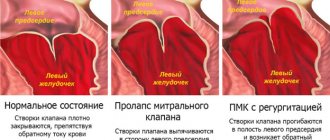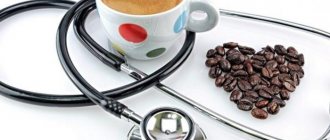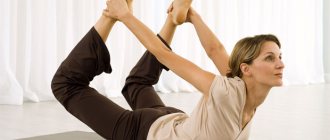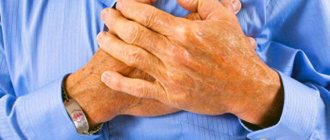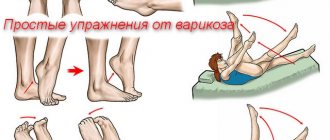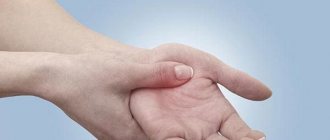And today there are even athletes among heart patients. However, for such people it is not sport that is more beneficial, but physical education. Moreover, it is simply necessary for many of them.
Proper exercise is beneficial for people with hypertension, coronary artery disease, heart failure and other heart diseases. They improve the quality of life, slow down the progress of the disease, and prevent the development of heart attacks, strokes, heart failure and other serious complications. If there is no exacerbation or decompensation of the disease, then moderate exercise is not only contraindicated, but also necessary. But it should be understood that the level of load depends on the state of the cardiovascular system, blood pressure, pulse rate, and pain syndrome. And only a doctor can determine it for sure. Therefore, if you are planning to engage in physical education, it is better to consult with him.
Article on the topic Winter and the heart. What can help you protect yourself from a heart attack?
How much and what is the best way to exercise? Here are some tips for hypertensive patients from the influential professional medical organization British Heart Foundation:
Try to exercise every day.
Your goal is at least 2.5 hours of study per week.
One session should last at least 10 minutes, and physical activity should be of moderate intensity. That is, your breathing rate and heart rate should be faster than usual, and you should feel warmed up. This happens when walking fast, cycling, or swimming.
Lifting weights and working with weights are undesirable, as they raise blood pressure higher.
A set of exercises for people with heart disease
Warm-up (7–10 minutes): brisk walking, light jogging, various stretches and bends. You can do all this by changing positions - standing, sitting, lying down.
Main part:
- Sitting on a chair
- Place your palms on your shoulders and rotate your arms bent at the elbows forward, then back.
- Palms behind your head, elbows to the sides. Alternately touch the back of the chair with your elbows, inhale, and exhale when returning to the starting position.
Article on the topicDon't give in to pressure! How to avoid becoming hypertensive?
- Hands on the belt. Try to bring your elbows forward as much as possible, then back.
- Hands on hips. Bend your legs and alternately raise them to a horizontal position. (Option: raise your legs together.)
- The arms hang freely, the back is straight. We lift our legs alternately, bending at the knee, as close to the chest as possible. (Option: you can help with your hands; they are placed below the knee and the legs are pulled towards the chest.)
- The starting position is the same. Turning the head to the sides or rotating the neck. Perform slowly and with maximum amplitude.
- The starting position is the same. Raise your shoulders, tightening your chest. We lower our shoulders and chest gradually in 4-6 stages in jerks, exhaling.
- Standing
- Feet shoulder width apart. Raise your arms up through the sides (inhale) and lower them in the same way, bending down and exhaling forcefully and waving your arms.
- Starting point – hands on the belt. We alternately raise one arm up and above the head, tilting the body to the side.
- The original is the same. Turn your torso to the sides, then rotate your pelvis.
- Legs are wider. Alternately, squatting on each leg, we transfer the body load to it.
- One leg is in front, the other is behind. We bend the front leg at the knee (resting on it with our hands above the knee), transfer the body weight to it and spring 3-4 times. Then for the other leg.
- Feet at body width, arms forward and horizontally. We raise our legs to them alternately (straight or bending at the knee).
- Squats with arms extended forward.
We ran away from a heart attack and caught up with him. How sports can lead to atherosclerosis Read more
End (5-10 minutes): Slow walking with deep breathing, raising and lowering your arms. Smooth tilts and rotations. Stretching the body and limbs. Shaking arms and legs.
Each exercise is done 5–10 times, the tempo of movements and amplitude are arbitrary, depending on your capabilities and condition.
Physical culture in the prevention of cardiovascular diseases
Diseases of the cardiovascular system are currently the main cause of death and disability in economically developed countries. Every year, the frequency and severity of these diseases are steadily increasing; heart and vascular diseases are increasingly occurring at a young, creatively active age.
Diseases of the cardiovascular system include: myocardial dystrophy, myocarditis, endocarditis, heart defects, pericarditis, atherosclerosis, coronary heart disease (angina pectoris, myocardial infarction), hypertensive and hypotensive diseases, obliterating endarteritis, thrombophlebitis, varicose veins, etc. Special attention deserves coronary heart disease - a disease associated with acute or chronic dysfunction of the heart muscle due to a decrease in the supply of arterial blood to the myocardium. Varieties of ischemic disease are angina pectoris and myocardial infarction. Coronary disease occurs insidiously, often (in 35-40% of cases) without clinical symptoms, causing millions of cases of disability.
The spread of the disease is facilitated by a number of external and internal environmental factors (“risk factors”). From the group of socio-cultural factors, the most important are: consumption of high-calorie foods rich in saturated fats and cholesterol (overweight, obesity); smoking; “sedentary” (inactive) lifestyle; stressful conditions of modern life in large cities. Among the violations of bioimical and physiological regulatory mechanisms, the following are important: hypercholesterolemia, hypertriglycerodemia, a number of forms of hyperlipoproteinemia, impaired tolerance to carbohydrates, arterial hypertension, etc. Therefore, to strengthen the cardiovascular system, it is necessary to get rid of excess weight, eat less fatty foods and more vegetables and fruits, and also engage in physical exercise.
The influence of physical exercise on the state of the cardiovascular system of the human body.
Systematic physical training affects almost all organs and systems of the human body. What happens to the cardiovascular system under the influence of long-term physical training? In trained people, myocardial contractility significantly improves, central and peripheral blood circulation increases, efficiency increases, heart rate decreases not only at rest, but also under any load, up to maximum (this condition is called training bradycardia), systolic, or stroke, blood volume. Thanks to the increase in stroke volume of blood, the cardiovascular system of a trained person copes with increasing physical activity much easier than that of an untrained person, completely supplying blood to all the muscles of the body that take part in the load under high stress.
The heart weight of a trained person is greater than that of an untrained person. The heart volume of people engaged in physical labor is also much larger than the heart volume of an untrained person. The difference can reach several hundred cubic millimeters.
As a result of an increase in stroke volume in trained people, minute blood volume also increases relatively easily, which is possible due to myocardial hypertrophy caused by systematic training. In an untrained person, the increase in stroke volume of blood is mainly carried out due to an increase in the number of heart contractions. Sports cardiac hypertrophy is an extremely beneficial factor. At the same time, not only the number of muscle fibers increases, but also the cross-section and mass of each fiber, as well as the volume of the cell nucleus. With hypertrophy, metabolism in the myocardium improves. With systematic training, the absolute number of capillaries per unit surface area of skeletal muscle and heart muscle increases.
It has long been established that people who engage in systematic physical labor and exercise have wider heart vessels. If necessary, their coronary blood flow can be increased to a much greater extent than in physically inactive people. But, most importantly, thanks to the economical work of the heart, trained people spend less blood on the same work for the heart than untrained people.
Under the influence of systematic training, the body develops the ability to very economically and adequately redistribute blood to various organs. Let us remember the unified energy system of our country. Every minute, the central control panel receives information about the demand for electricity in various zones of the country. Computers instantly process incoming information and suggest a solution: increase the amount of energy in one area, leave it at the same level in another, reduce it in a third. It's the same in the body. With increasing muscular work, the bulk of the blood goes to the muscles of the body and to the heart muscle. Muscles that do not participate in work during exercise receive much less blood than they received at rest. Blood flow in internal organs (kidneys, liver, intestines) also decreases. Blood flow in the skin decreases. The only thing that doesn't change is the blood flow in the brain.
Thus, systematic physical training has an extremely beneficial effect on a person’s cardiovascular system and, in general, on his entire body. The effects of physical activity on the cardiovascular system are shown in table. 1.
Table 1
Differences in the state of the cardiovascular system of trained and untrained people.
| Indicators | Trained | Untrained |
| Anatomical parameters: | ||
| weight of the heart volume of the heart capillaries roundabout vessels of the heart | 350-500g. 900-1400ml large quantity | 250-300g 600-800ml small quantity |
| Physiological parameters: | ||
| resting pulse rate stroke volume resting minute blood volume systolic blood pressure resting coronary blood flow myocardial oxygen consumption at rest coronary reserve maximum minute blood volume | less than 60 beats/min 100ml More than 5 l/min Up to 120-130 mmHg 250ml/min 30ml/min Large 30-35 l/min | 70-90 beats/min 50-70 ml 3-5 l/min Up to 140-160 mmHg 250 ml/min 30 ml/min Small 20 l/min |
| Vascular condition: | ||
| elasticity of blood vessels in old age, presence of capillaries on the periphery | Elastic Large quantity | Lose elasticity Small amount |
| Disease susceptibility: | ||
| atherosclerosis angina pectoris myocardial infarction hypertension | Weak Weak Weak Weak | Expressed Expressed Expressed |
2. Selection and optimal dosage of physical. The healing mechanism of the effects of physical exercise in various cardiovascular diseases
For students with diseases of the cardiovascular system, a group method of training is recommended, preferably on the street, in a park or in a public garden, that is, physical education combined with hardening. The lesson is structured so that cyclic movements predominate (various types of walking and running, their combination, skiing, skating, breathing exercises). In winter, you need to make sure that students breathe through their nose. Relaxation exercises are shown. Exercises with holding your breath, straining, etc. are excluded.
During classes, it is necessary to monitor the student’s pulse, breathing, skin color and general condition. Morning exercises and hardening are very important. In the autumn-spring period - vitaminization (taking vitamins C and E is especially recommended). If possible, it is recommended to carry out ultraviolet radiation.
Exercise is a scientifically proven means of preventing cardiovascular diseases. Numerous studies have proven that a decrease in physical activity is a risk factor for the most common and severe diseases of the heart and blood vessels. Therefore, regular exercise reduces the likelihood of developing circulatory diseases.
Early treatment of cardiovascular diseases prevents their further development. Often, treatment does not require the use of medications; It is enough just to organize a healthy lifestyle: proper motor mode, a reasonable balance of work and rest, a rational, balanced diet, quitting smoking and alcohol, reducing emotional and mental stress. The most important component of health measures is therapeutic physical training, which promotes recovery or stops the further development of the disease.
To prevent diseases of the cardiovascular system, physical education is recommended for everyone, but especially for those who have risk factors. Various forms of training can be used. For the adult population, they are held in health groups based on the type of general physical training, and running clubs. Many healthy people exercise on their own. The method and dosage of physical activity are selected in accordance with the medical group to which the participants are assigned, age, gender, and level of physical fitness.
Organized and independent classes use gymnastic exercises, walking, running, swimming, skiing, rowing, games, and hiking.
Gymnastic exercises are easily dosed and have a targeted effect; they develop muscle strength, strengthen the ligamentous apparatus, improve joint mobility, improve coordination of movements, the ability to breathe properly and relax muscles. Gymnastic exercises have a varied effect on the central nervous system: most of them, especially exercises for coordination of movements and speed-strength exercises, excite, and exercises in muscle relaxation, breathing and movements performed very slowly, enhance inhibitory processes. Gymnastic exercises also have a pronounced effect on internal organs. For therapeutic purposes, they are selected in such a way as to specifically change certain functions of the body, promoting recovery. For example, in case of hypotension, strength, speed-strength and static exercises increase blood pressure, and in case of hypertension, exercises in muscle relaxation, breathing, for small muscle groups and some others help to reduce it.
Breathing exercises and muscle relaxation exercises have a general healing effect. Therefore, it is necessary to specially train students in the ability to control their breathing and relax their muscles.
Walking is a valuable and important means of therapeutic and health-improving physical culture. This is a natural and habitual form of muscle activity. While walking, many muscle groups of the torso, legs and arms are involved. When practicing independently, walking is the most accessible, easily dosed form of exercise.
For therapeutic purposes, walking is used at a slow pace (60-80 steps per minute, speed no more than 3 km/h), at an average pace (90-100 steps per minute, speed 3.5-4.5 km/h) and at fast (100-120 steps per minute, speed 5-6 km/h). A faster walking pace is not advisable. The length and frequency of steps during different periods of training depend on the tasks. In the beginning, a shorter stride and slower tempo are usually used, then the stride is longer and the tempo is increased. Walking at an average and fast pace gives a more pronounced effect than walking a long distance at a slow pace. Breathing while walking should be coordinated with the steps (exhalation is slightly longer than inhalation): first, inhale for 2 steps, and exhale for 3-4 steps, then inhale for 3-4 steps, and exhale for 5-6 steps.
At the beginning of health walking classes, light loads are used. Do I train students during this period? breathe correctly while walking. Walking pace is normal. Then they begin gradual, systematic training. First, increase the walking distance at the same pace; subsequently increase the pace, but reduce the distance by 10-20%; Then, as training increases, the distance and pace of walking are increased again.
The method of exercise therapy depends on the nature of the disease and the pathological changes caused by it, on the stage of the disease, the degree of circulatory failure, the state of the coronary blood supply, and the functional state of the patient.
In case of severe manifestations of the disease, severe heart failure or coronary circulation, exercise therapy classes are structured in such a way as to first of all have a therapeutic effect: to prevent possible complications - by improving peripheral circulation and respiration; help compensate for weakened heart function - due to the activation of extracardiac circulatory factors; improve trophic processes - by improving blood supply to the myocardium. For this, low-intensity physical exercises are used - for small muscle groups, performed at a slow pace, breathing exercises and muscle relaxation exercises.
When the patient's condition improves, physical exercises are used in a complex of rehabilitation measures to restore performance (although they continue to be used to implement therapeutic goals). Systematic training is of primary importance, i.e. during classes there is a gradual increase in physical activity, which is achieved: at first - through a greater number of repetitions; then - by increasing the amplitude and tempo of movements; further - through the use of more difficult physical exercises and starting positions. From low intensity exercises they move on to moderate and then maximum intensity exercises; from the initial positions lying and sitting - to a standing position. In the future, dynamic cyclic loads are used: walking, working on a bicycle ergometer, running, etc.
After completion of rehabilitation treatment and for chronic diseases, exercise therapy is used to maintain the achieved treatment results - to improve blood circulation and stimulate the functions of other organs and systems. Physical exercises and the dosage of physical activity are selected depending on the residual manifestations of the disease and the functional state of the patient. A variety of physical exercises are used (gymnastics, elements of sports, games), which are periodically replaced.
For effective treatment and rehabilitation of patients, the dosage of physical activity that is adequate to the patient’s condition is of great importance. To determine it, many factors must be taken into account: manifestations of the underlying disease and the degree of coronary insufficiency, level of physical performance, hemodynamic state, and the ability to perform household physical activity. Taking these factors into account, a division into four functional classes has been developed for patients with coronary heart disease; For each class, physical activity and training programs are regulated (for more details about functional classes, see section 3.5).
The method of exercise therapy for diseases of the cardiovascular system depends on the degree of circulatory failure.
1. In case of chronic heart failure of the third degree, exercise therapy is used only when circulatory failure is stabilized and during the period of intensive treatment when the patient’s condition improves. Therapeutic exercises are aimed at preventing possible complications, stimulating compensation and improving the patient’s mental state. Properly selected exercises do not hinder, but, on the contrary, facilitate the work of the heart, as they activate extracardiac circulatory factors. These exercises include active movements for small and medium muscle groups. Movements in large joints of the limbs are performed with incomplete amplitude, with a shortened lever, sometimes with the help of a physical therapy instructor or passively. Exercises for the trunk muscles are used only in the form of turns on the right side and slight elevation of the pelvis. Static breathing exercises are performed without deepening breathing.
The exercises are performed at a slow pace, from the starting position lying on your back (with the head of the chair raised). Number of repetitions: for large joints - 3-4 times, for small joints - 4-6 times.
2. In case of chronic heart failure of the second degree, exercise therapy is aimed at preventing possible complications: improving peripheral circulation; elimination of stagnation; improvement of metabolic processes in the myocardium; Providing a slight general tonic effect on the body, increasing the functions of all its systems (including the central nervous and endocrine).
2.1. In case of heart failure of degree IIB, the method of exercise therapy is basically similar to the method for failure of degree III - only the number of repetitions of movements in small joints increases (up to 8-10 times); breathing exercises are performed with lengthening and slight intensification of exhalation, which largely improves venous outflow and improves peripheral circulation. Exercises for the trunk muscles begin to be used, which are performed with incomplete amplitude, the number of repetitions is 3-4 times. Starting positions - lying and sitting.
2.2. In case of heart failure of degree IIA, the number of exercises for medium and large muscle groups of the limbs and torso is increased in exercise therapy. The amplitude of body movements gradually increases (but remains incomplete). All movements are performed in coordination with breathing. Special breathing exercises, static and dynamic, are performed with intensification and lengthening of exhalation. Movements in large joints are performed at a slow pace, number of repetitions - 4 - 6 times; in small joints - at an average pace, number of repetitions - 8 - 12 times. Starting positions - lying, sitting and standing. When the patient's condition improves, the task is to gradually adapt him to moderately increasing physical activity. Measured walking begins to be used; the distance gradually increases to several hundred meters; walking pace is slow. Gymnastic exercises become more complicated, the amplitude and tempo of movements increase. The number of repetitions of exercises for large muscle groups increases to 6-12 times.
3. In case of chronic heart failure of the first degree, the main task of exercise therapy is the adaptation of the cardiovascular system and the entire body of the patient to household and industrial physical activity. Therapeutic gymnastics classes include exercises for medium and large muscle groups, exercises with objects (gymnastic sticks, balls), with small weights (dumbbells, medicine balls weighing 1-1.5 kg) and with resistance; sedentary games, game tasks; various walking, short running at a slow pace. Movements that are complex in coordination are performed with full amplitude. The number of repetitions is 8-12 times. These exercises alternate with exercises for small muscle groups of the limbs and with breathing exercises. All basic starting positions apply: standing, sitting and lying down. In addition to therapeutic exercises, morning hygienic exercises and measured walking are used. The distance gradually increases from 300 - 500 m to 1 -1.5 km. Walking pace - up to 70 - 80 steps/min (speed - 50-60 m/min). In a compensated state (H0), the task of exercise therapy is to train the cardiovascular system and the body as a whole through gradually increasing physical activity.
3. Limitations and contraindications to the use of physical exercises for various cardiovascular diseases
Physical exercises as a means of treatment and rehabilitation are indicated for all diseases of the cardiovascular system. Contraindications are only temporary. Therapeutic exercise is contraindicated in the acute stage of the disease (myocarditis, endocarditis, angina pectoris and myocardial infarction during the period of frequent and intense attacks of pain in the heart, severe heart rhythm disturbances), with an increase in heart failure, and the addition of severe complications from other organs.
When the acute effects are relieved and the increase in heart failure stops, and the general condition improves, you should begin physical exercise. Exercise therapy is widely used for diseases of the circulatory system in the acute period during recovery and, in reality, as a factor in maintenance therapy.
Contraindications:
- acute phase of rheumatism, endo- and myocarditis;
- severe disturbances of the rhythm and conduction system of the heart;
- acute heart failure (pulse more than 104-108 beats/min, severe shortness of breath, pulmonary edema);
- stage III circulatory failure
4. A set of exercises for the prevention of diseases of the cardiovascular system
A set of exercises for cardiovascular diseases
- Starting position (i.p.) - lying on your back, arms bent at the elbows and resting on them. Bend your fingers and toes at the same time, then straighten. Repeat 4-6 times. The pace is slow. Breathing is free.
- I. p. - the same, arms along the body. Slide your palms along the body up to the armpits - inhale, return to i. p. - exhale. Repeat 3 times. The pace is slow.
- I. p. - the same, arms are bent at the elbows and rest on them. Simultaneously move your hands and feet towards you, then away from you. Repeat 4-6 times. The pace is slow. Breathing is free.
- I. p. - the same, hands down. Push your stomach out - inhale, lower it - exhale. Repeat 3 times. The pace is slow.
- I. p. - the same. Move your legs alternately by half feet for 6-8 counts towards yourself, bringing the bending in the knee and hip joints to a right angle, and also step half a foot away from you for 6-8 times. Repeat 2-4 times. The pace is slow. Breathing is free.
- I. p. - the same. Stretch your arms up above your head - inhale, lower - exhale. Repeat 3 times. The pace is slow.
- I. p. - the same. Bend your legs at the knees and hip joints and place your feet towards your buttocks, left hand on your waist. Place your knees to the right/grab the headboard or bedside table with your right hand and turn while exhaling onto your right side, remove your left hand from your belt, lie down for 1-2 minutes.
Transition to a sitting position with your legs down. From a lying position on the right side, legs bent at the knee and hip joints, left hand on the belt - simultaneously lowering your legs, with your right hand lean on the edge of the bed or grab it - inhale, take a sitting position with your legs lowered - exhale. The pace is average.
Move to a standing position. From a sitting position, with your hands on your belt or your right hand on your belt and your left hand resting on a chair or bedside table, tilt your torso forward, keeping your head straight, inhale and stand up as you exhale.
Transition from a standing position to a sitting position. Hands on the belt or the right hand on the belt, and the left one resting on the back of a chair or the edge of the table - tilt the torso forward by bending the hip joints and sit down as you exhale.
Walking without shortness of breath. Hands on the belt. Slowly raise one leg - exhale, lower it in front of you - inhale, do the same with the other leg, thus moving forward. Perform the exercise 6-8 times, gradually, over several days, increasing the “traveled” distance. After the normal breathing rhythm is restored, start walking like this - first 2 steps while exhaling, then 4, 6, 8 steps while exhaling, then proceed to normal walking.
Walking up stairs without shortness of breath. The left hand is on the belt or on the staircase railing, the right hand is lowered. Slowly, as you exhale, lower your right leg one step lower and place your left leg on it: inhale - during a pause, when both legs are on the same step, also while exhaling, lower your left leg and place your right leg on it. Climb up the stairs also while exhaling, alternately placing one foot on the step and placing the other on it. Inhale while both legs are on the same step. Walk down the stairs with a side step until you feel that you are breathing freely and can exhale and go down 4-6 steps at once. It is also recommended to climb up the Staircase while exhaling, not in a straight line, but diagonally, placing your feet not perpendicular to the step, but diagonally.
Conclusion
When performing physical exercises, the pulse quickens, blood pressure rises, the amount of circulating blood and the number of functioning capillaries in the skeletal muscles and myocardium increase.
Therapeutic exercises for diseases of the cardiovascular system, maximally activating the effect of extracardiac circulatory factors, contribute to the normalization of impaired functions.
Exercise therapy is widely used for diseases of the circulatory system in the acute period during recovery and, in reality, as a factor in maintenance therapy.
Exercise therapy is effective only if long-term, systematic classes are carried out with a gradual increase in load both in each of them and throughout the course. Both the coach and the student must know this in order to achieve appropriate results.
Expert opinion
Cardiologist, Doctor of Medical Sciences, Professor, Head of the Department of Clinical Functional Diagnostics and Scientific Secretary of the Moscow State Medical and Dental University named after. A. I. Evdokimova Yuri Vasyuk:
– Exercise is beneficial for most patients with cardiovascular disease. Exceptions are mainly associated with periods of exacerbation of the disease or its decompensation. Physical education is important even with heart failure, which can be the outcome of any heart and vascular disease. In this condition, the contractility of the heart decreases, and it pumps blood worse; over time, the person experiences shortness of breath, swelling, and other symptoms. Physical exercise is recommended for all patients with chronic heart failure (CHF) if the disease is stable and there is no need for emergency treatment.
Studies have shown that regular physical training for three months improves exercise tolerance and improves the absorption of oxygen by the body. But these positive effects disappear after three weeks if you stop exercising. Therefore, patients with chronic heart failure are recommended to exercise regularly. This is recorded in the official “National Guidelines for the Diagnosis and Treatment of CHF.”
Exercise therapy technique for congenital and acquired heart defects
In the preoperative period (several weeks before surgery), the following exercise therapy tasks are solved:
— moderate mobilization of the reserves of the cardiorespiratory system;
— facilitating the work of the heart due to the inclusion of extracardiac circulatory factors;
- combating the manifestations of neurosis, anxiety, building the patient’s confidence in the successful outcome of the operation;
— mastering exercises in the early postoperative period (learning diaphragmatic breathing and techniques for painless coughing and lifting).
Depending on the general condition of the patient, the results of the examination and the indicators of functional tests for constructing a method of exercise therapy, patients with congenital heart defects are divided into three groups: A, B and C.
Group A
– patients with minor complaints of mild shortness of breath and fatigue after physical activity. Hemodynamic parameters – without pronounced disturbances. Blood discharge (open aortic duct, atrial and interventricular septal defects) occurs “from left to right,” i.e. excess blood enters the pulmonary circulation. The results of functional tests are regarded as favorable.
Group B
– patients in a state of moderate severity with complaints of weakness, shortness of breath, palpitations and fatigue. The examination indicates hypertension in the pulmonary circulation. These patients may experience: tetralogy of Fallot, various forms of disturbance of the great vessels, a single ventricle, etc. The results of functional tests are acceptable.
Group B
– patients in serious condition with complaints of shortness of breath with little physical exertion and at rest, fatigue, palpitations, interruptions in cardiac function, frequent headaches. This includes patients with stenosis, coartation of the aorta and other congenital defects in which the flow of blood into the systemic circulation is difficult. The results of functional tests are satisfactory.
In the preoperative period, classes with these groups of patients are carried out according to the following scheme (Table 1).
Table 1
Distribution of patients with congenital heart defects into groups for PH exercises (according to E.I. Yankelevich, 1995)

